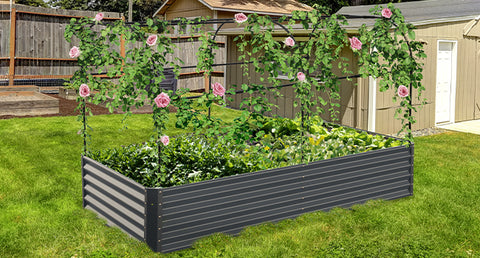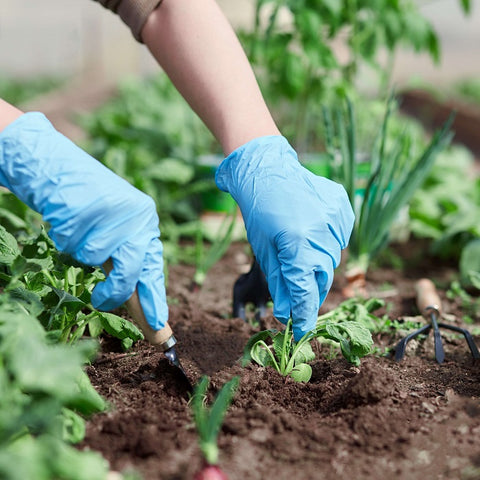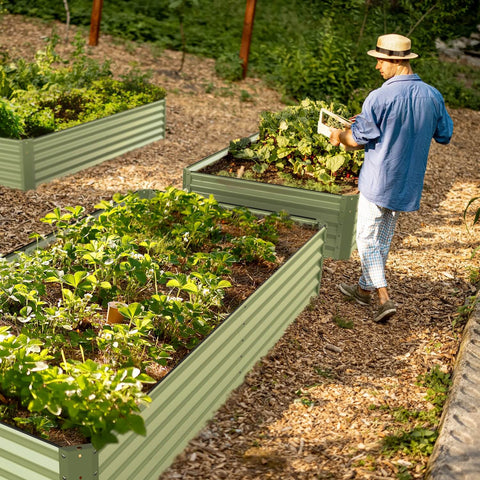Whether you've already planted a tray of seeds indoors or are just getting your plants ready to grow, we're here to encourage you to try something different this year. If you've ever tended to stock up on a few (OK, dozens) of leftover plastic nursery POTS, you know they can take up a lot of space. Seed trays also require too much storage space, not to mention that they end up destroying and filling landfills. The following content also has some reference value for raised garden beds.
What if I told you to get rid of the plastic and grow quality seedlings instead? Yes, that's right. A better way to plant seeds is to use a soil barrier.

What is blocking soil?
Fiefdoms are nothing new; In fact, the practice dates back at least 2,000 years, when the Aztecs built so-called "water gardens" in Mexico City, where long strips of land surrounded by water were used to grow plants and vegetables. This incredibly successful method of growing plants without the use of containers continues today, using a product created and improved over the past 100 years: soil blockers.
A soil blocker is a metal spring-loaded tool that forms and compresses cubes of specialized soil mixtures. By eliminating plastic POTS, the soil increases oxygen flow from all directions, allowing roots to thrive without restrictions and ultimately producing plants with healthy roots. Not only are these seedlings not tied to the roots, but they have much less transplant shock than other potted plants.
Less waste and healthier plants, what are you waiting for? Here's how to get square this spring.
How do you start the fief
Supply need
Soil Blocking systems: These metal blockers come in a variety of sizes and typically create square blocks of 3/4 "to 4". The beauty of them is that they often work together, and in the same way that you would "potted" larger seedlings (like tomatoes and peppers) before transplanting, you can insert smaller pieces of soil into the larger ones for more mature growth before they enter the garden. The size you choose depends entirely on how you want to grow and how much space you have to store the device. I like this all-in-one system, but if you don't want to fully invest until you get the hang of it, I recommend starting with 2-inch blockers and then expanding your setup to accommodate future growing seasons.

Nursery or growing tray: Your building blocks need a home where they can be left undisturbed until the day of transplantation. Nursery trays with lips are ideal for bottom watering, and even better if you can poke a few holes in them so the excess water can drain out. Some people like to water with dips -- simply use a perforated nursery tray to hold the clods and dip them into a larger solid base dish. What works for you depends on how much planting space you have available.
Coco Cole: Pass the peat moss, please! We are running out of natural resources and it is time to switch to coconut husks. Not only is this a more sustainable option, it requires less water to fully hydrate and can even promote the growth of beneficial bacteria. We also like to use this method in our houseplant soil mix!
Compost: Whether you find enough compost from your own bin or need to grab a bag at the nursery, compost is a key ingredient in plant health because it promotes growth (hello, natural fertilizer), retains moisture, and prevents disease.
Sulfuric Rock: One of the most widely used organic fertilizers, this natural ingredient adds a mixture of phosphorus and calcium to promote healthy plant growth as well as healthy roots and flowering.
Kelp Powder: Another all-natural powerhouse, this powder increases natural plant growth hormones such as auxin, cytokines, and gibberellin (aka: Powerful Plant hormones). Think of it like a milkshake you give your seedlings.
Soil nutrition bowl recipe
There are many different recipes, and even some pre-mixed bags, but we've chosen a simple one to try first - however, we encourage you to experiment and find the mix that best suits your climate and growing conditions. We call this "non-recipe" because personal modifications are absolutely necessary. Depending on whether you're growing indoors, in a greenhouse, or on an outdoor potting table, your blocks will respond differently to temperature and humidity levels. Be patient, keep adding, keep adjusting, and you'll find your growth groove!

composition
8 cups coconut water
2 cups compost
2 tablespoons sulfuric rock
2 tablespoons kelp powder
3-4 cups of water
direction
Strain the coir and compost through a fine mesh to eliminate clumps. Put all the ingredients in a large basin and mix well. Add the water, one cup at a time, stirring as you drink. This should eventually have the consistency of a damp sponge, rather than being overly wet and dripping. When the mixture holds its shape (tested by making a ball), you know you have achieved the perfect consistency.
Too wet and runny? Add more coconut milk and compost. Can't stick together? Add a little more water. You'll know when your custom mix is right - remember, this is an imperfect dance and may need to be adjusted for your particular weather and the organic materials used.
How do you create your soil blocks
- Make clods: Using your clod tool, press in the seed starting mixture, making sure each compartment of the tool is completely filled and packed. Place your blocks on the nursery tray that will be where they will grow until transplant day. If the blocks fall apart, you'll need to revisit your mixture and make some of the changes described above.
- Start sowing: Each soil block has a small indentation at the top; Depending on the type of seed you start planting, you can simply place the seed on top or plant it to a depth twice the size of the seed. Use chopsticks or a rubber brush to gently dig out a small hole with no more than two seeds per piece.
- Water: Drooling is your friend! Some built multiple tray systems, carefully dipping blocks into water, others punched drainage holes in individual childcare trays. Whatever you do, the key is not to let water fall over your head or let the blocks sit in standing water - both of which can cause them to fall apart. If drying out the top of your block becomes a problem, you can lightly water the seed overhead with a sprayer after it has fully germinated. If too much moisture causes algae problems, wait until the top of the pot is dry before watering.
- Potting and transplanting: If certain plants need to be "potted" before being transplanted into the garden, there are soil blocking systems that allow microblocks to be embedded in larger 2 - and 4-inch blocks. Simply drop one of the provided square punched pieces into your larger blocking tool, which will create space for you to drop on the smaller seedling square. It couldn't be simpler.
Prior to transplant day, it is recommended to harden the plant as you would normally do in a container. The key is to keep sunlight and temperature in mind, as your blocks are likely to dry faster when exposed to new conditions. Use a spade or hori hori knife to dig a pocket slightly larger than a block of wood and stick it into a garden bed or straight into the ground.
Now, stand back and smile, knowing that you have just given the seedlings a sustainable and strong start to a beautiful growing season ahead!









